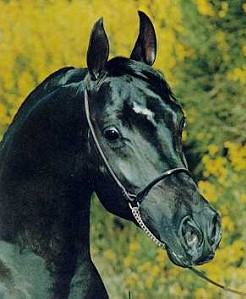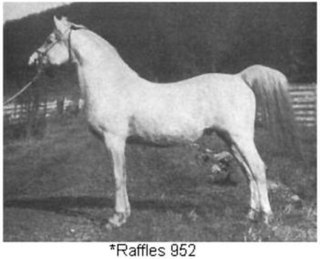Related Research Articles

The Arabian or Arab horse is a breed of horse that originated on the Arabian Peninsula. With a distinctive head shape and high tail carriage, the Arabian is one of the most easily recognizable horse breeds in the world. It is also one of the oldest breeds, with archaeological evidence of horses in the Middle East that resemble modern Arabians dating back 4,500 years. Throughout history, Arabian horses have spread around the world by both war and trade, used to improve other breeds by adding speed, refinement, endurance, and strong bone. Today, Arabian bloodlines are found in almost every modern breed of riding horse.

The Crabbet Arabian Stud, also known as the Crabbet Park Stud, was an English horse breeding farm that ran from 1878 to 1972. Its founder owners, husband and wife team Wilfrid Scawen Blunt and Lady Anne Blunt, decided while travelling in the Middle East to import some of the best Arabian horses to England and breed them there. They maintained the Sheykh Obeyd estate near Cairo to facilitate this. Their daughter Judith Blunt-Lytton, 16th Baroness Wentworth carried on the stud until her death. The stud was sold up in 1971, but its bloodlines continue to influence the breed worldwide in the 21st century.

El Mokhtar was an Arabian horse, and one of three black Arabian stallions used to portray "The Black" in the second Black Stallion film, The Black Stallion Returns.
"Al Khamsa" is a designation applied to specific desert-bred bloodlines of the Arabian horse considered particularly "pure" by Arabian horse breeders, who sometimes also describe such lines with by use of the Arabic word asil, meaning "pure".

Skowronek was an Arabian stallion foaled in 1908 or 1909. He was bred by Count Józef Potocki who owned the Antoniny Stud in Poland. He was imported to England as a young horse. Upon purchase by Lady Wentworth, Skowronek became a foundation stallion at Lady Wentworth's Crabbet Arabian Stud. He was most often crossed on mares who were daughters or granddaughters of the stallion Mesaoud, another foundation stallion for Crabbet, who had been bred by Ali Pasha Sherif and imported from Egypt to England by Lady Wentworth's parents, Wilfrid and Lady Anne Blunt.

Mesaoud, an Arabian stallion, foaled 1887, was one of the foundation sires of the Crabbet Arabian Stud in England. Bred in Egypt by Ali Pasha Sherif, he was imported to England by Wilfred and Lady Anne Blunt in 1891. He is recognized as an Al Khamsa Arabian, with verifiable lineage tracing to the Bedouin of the desert.
Henry B. Babson was an American entrepreneur, investor in phonograph technology, and notable breeder of Arabian horses. He moved to Chicago at the age of 17 at the urging of inventor Leon Douglass. While working at the 1893 World's Columbian Exposition, better known as the Chicago World Fair, Babson first encountered purebred Arabian horses brought from the Middle East for exhibition, and decided that some day he would own such horses for himself.

Raffles was an Arabian stallion foaled in 1926 and imported to the United States by Roger Selby in 1932. Raffles was bred by Lady Wentworth of the Crabbet Arabian Stud.

Khemosabi (1967–2001) was a bay Arabian stallion with four stockings and a blaze, who had significant accomplishments in the horse show ring, winning multiple National Championships in both halter and western pleasure performance competition. These wins earned him the highest level achievement award offered by the Arabian Horse Association: the Legion of Masters. In the course of his breeding career, he sired over 1200 foals. Of these, over 300 were show champions and 75 won national championships.

Indraff (1938–1963) was a gray Arabian stallion, foaled on May 9, 1938 and bred by Roger Selby of Ohio. His sire was Raffles and his dam was Indaia. Both his sire and dam were bred by the Crabbet Arabian Stud in England and imported to the United States by Selby.

Raseyn (1923–1959) was an Arabian stallion foaled in 1923 and bred by Lady Wentworth of the Crabbet Arabian Stud. After being imported into the United States by W.K. Kellogg in 1926. He was part of a large shipment of horses that Carl Schmidt, later Carl Raswan, purchased from Lady Wentworth for Kellogg's new ranch in Pomona, California.

Witez II was a bay Arabian stallion foaled at the Janów Podlaski stud in Poland. He spent his early years at Janów at a time when Poland was under occupation by Nazi Germany before ultimately arriving in the United States in 1945, where he lived for the remainder of his life until his death. His name came from an archaic Polish word meaning "chieftain, knight, prince and hero."

Bask, bred at the Albigowa State Stud in Poland, was a bay Arabian stallion who was imported into the United States in 1963 by Dr. Eugene LaCroix of Lasma Arabians and became a major sire of significance in the Arabian breed.
Fadjur, Foaled April 12, 1952, died 1983, was an Arabian horse who was bred in Spokane, Washington and resided in Stockton, California. A bay stallion, he was nicknamed "The Fabulous Fadjur" and sired numerous progeny from the Jack Tone Ranch over a thirty-year period.

Aswan (1958–1984), originally named Raafat in Egypt. Aswan was a highly influential grey Egyptian-bred Arabian stallion who stood at the Tersk Stud in Russia. Sired by Nazeer out of Yosreia, he was given as a gift to the Soviet Union by the Egyptian government in 1963, in return for Soviet help in building the Aswan Dam.
Nazeer was a gray Arabian stallion from Egypt. He was sired by Mansour out of Bint Samiha.
The Tersk Stud is a horse breeding farm, and it was used to restore the Russian horse population, which suffered heavy losses during the 1917-1923 Revolution. It was officially established on 11 February 1921, on the orders of Marshal Semyon Budyonny.

Sheila Varian was an American breeder of Arabian horses who lived and worked at the Varian Arabians Ranch near Arroyo Grande, California. She grew up with a strong interest in horses, and was mentored in horsemanship by Mary "Sid" Spencer, a local rancher and Morgan horse breeder who also introduced Varian to the vaquero or "Californio" tradition of western riding. She started her horse ranch, Varian Arabians, in 1954 with the assistance of her parents. Raising and training horses was her full-time occupation beginning in 1963. She used vaquero-influenced methods of training horses, although she adapted her technique over the years to fit the character of the Arabian horse, which she viewed as a horse breed requiring a smart yet gentle approach.
Ansata may refer to:

Naborr, originally named Nabor, was a gray Arabian stallion foaled in Russia at the Tersk Stud. He was sired by Negatiw, a Russian-bred stallion with Crabbet ancestry, out of the Polish-bred mare Lagodna. After establishing himself on the race track and show ring in the former USSR, Naborr was exported to Poland, where he lived for seven years, and from there was purchased for import to the United States by a wealthy Arabian horse breeder from Arizona, Anne McCormick. Upon her death, Naborr was sold in 1969 to Tom Chauncey and Wayne Newton for $150,000, which was at the time the highest price ever paid for an Arabian horse at auction. He went on to become a leading sire of champion Arabian horses in the United States and Canada.
References
- Carpenter, Marian K; Close, Pat (1999). Arabian Legends: Outstanding Arabian Stallions and Mares . Colorado Springs, CO: Western Horseman. ISBN 0-911647-48-1.